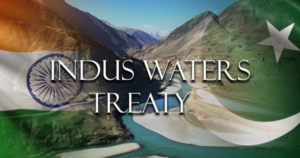Revisiting the Indus Waters Treaty: A Path to Sustainable Water Management
Context:
The Indus Waters Treaty (IWT) of 1960, which is an agreement between India and Pakistan regulating the use of the Indus River and its tributaries.
Relevance:
GS – 02 (India and its Neighborhood) (Groupings & Agreements Involving India and/or Affecting India’s Interests)
Prelims:
- Article IX of the IWT.
- Indus and its tributaries.
Mains Questions:
- Examine the recent judicial recourse taken by Pakistan under the Indus Waters Treaty (IWT) and its implications for India-Pakistan water relations and discuss the challenges posed by climate change to the current water allocation mechanisms under the IWT. (250 words)
Dimensions of the Article:
- The Indus Waters Treaty – Cooperation Amid Tensions.
 Addressing Disputes through Judicial Recourse.
Addressing Disputes through Judicial Recourse.- Future Water Supply Concerns.
- The Flawed Partitioning Logic.
- Embracing Equitable and Reasonable Utilization (ERU) and No Harm Rule (NHR).
- Prioritizing ERU and NHR.
- Revisiting the Indus Waters Treaty.
The Indus Waters Treaty – Cooperation Amid Tensions
- The Indus Waters Treaty (1960) has stood the test of time, fostering cooperation between India and Pakistan despite their strained relations.
- It has survived multiple conflicts and offered a detailed framework for dispute resolution. However, recent years have witnessed an increase in judicial recourse to settle disputes arising from India’s construction of hydroelectric projects on the Indus tributaries.
Addressing Disputes through Judicial Recourse
- Recently, Pakistan initiated arbitration at the Hague-based Permanent Court of Arbitration concerning the design elements of two hydroelectric projects on the Kishanganga and Chenab rivers.
- India objected, preferring a neutral expert process. Nevertheless, the court ruled in favor of Pakistan, asserting its competence to address the disputes.
Future Water Supply Concerns
- While the recourse to judicial measures may appear rational in a climate of mistrust, it is insufficient to meet the growing industrial, food, and energy needs of both countries.
- The IWT provides some certainty for future water supplies but lacks the flexibility to adapt to changing water availability due to climate change.
The Flawed Partitioning Logic
- The IWT’s partitioning of the rivers into eastern and western basins overlooks the need to treat the entire river basin as one unit to enhance resource capacity.
- This approach, rooted in optimal water use, clashes with Pakistan’s perspective of uninterrupted water flow to its side.
Embracing Equitable and Reasonable Utilization (ERU) and No Harm Rule (NHR)
- Reconciling divergent approaches can be achieved by incorporating the principles of ERU and NHR into the IWT.
- ERU aims for fair and reasonable water utilization, considering factors like climate change.
- The NHR obliges riparian states undertaking projects with transboundary effects to prevent harm to other riparian states.
Prioritizing ERU and NHR
- Both India and Pakistan claim their water uses align with the IWT. However, in times of conflicting interests, Article 10 of the 1997 Convention suggests prioritizing “vital human needs” concerning ERU and NHR.
- Although debatable, including these principles in the IWT could foster greater alignment.
Revisiting the Indus Waters Treaty
- Considering the lack of trust between India and Pakistan, the World Bank, a party to the IWT, can play a vital role in forming a transnational alliance of epistemic communities to develop convergent state policies.
- This collaboration may lead to the inclusion of ERU and NHR in the IWT, enhancing predictability for both nations.
Way Forward:
Revisiting the Indus Waters Treaty is an essential step towards ensuring sustainable water management in the region. By incorporating the principles of equitable and reasonable utilization and the no harm rule, India and Pakistan can move towards a shared vision of responsible water use, addressing future challenges posed by climate change and promoting cooperation.
Conclusion:
The Indus Waters Treaty has been a beacon of cooperation amidst the tensions between India and Pakistan. However, the increasing reliance on judicial recourse to resolve disputes highlights the need for a more flexible and adaptable approach. Integrating the principles of equitable and reasonable utilization and the no harm rule into the IWT can pave the way for sustainable water management and foster greater understanding between the riparian states. As the region faces the challenges of a changing climate, revisiting the treaty becomes an imperative step in securing a water-secure future for both nations.


 Addressing Disputes through Judicial Recourse.
Addressing Disputes through Judicial Recourse.

